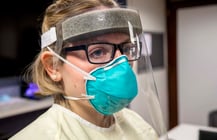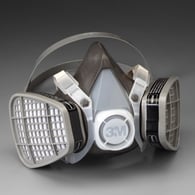In Defense of Fit
There is a lot of information floating around about the benefit and use of what many people are calling “masks” and what here, for clarity, will be called facial coverings. For a moment over the summer, it felt as though there was a chance these facial coverings might fade into the background, and we could all breathe a little easier (figuratively and literally). Unfortunately, the pandemic had other plans, and there was a resurgence of cases, leading many places to go back to the use of facial coverings.
With this shift and return to use, many people might be both wary and weary of the flip flopping on their facial covering, so this is meant to provide a quick rundown of where facial coverings fit into the realm of protection and prevention.
Most of the research available on the efficacy of facial covering use is on surgical masks a s these were what previously were used in healthcare settings for the purpose of limiting the expulsion of contagious particulates from the wearer. Surgical masks would be considered a higher level of “protection” (although they are explicitly stated as NOT being respiratory protection) than most available facial coverings being utilized by the public as they are at least required to have FDA approval on their ability to resist blood and bodily fluids and some level of filtration provided by the fabric itself.
s these were what previously were used in healthcare settings for the purpose of limiting the expulsion of contagious particulates from the wearer. Surgical masks would be considered a higher level of “protection” (although they are explicitly stated as NOT being respiratory protection) than most available facial coverings being utilized by the public as they are at least required to have FDA approval on their ability to resist blood and bodily fluids and some level of filtration provided by the fabric itself.
Recently, several sources have referred to facial coverings as personal protective equipment. The guidance that facial coverings are providing any significant protection against airborne particulates for the wearer is at the least misleading and at the worst dangerous.
The OSHA Fact Sheet: “Respiratory Infection Control: Respirators Verses Surgical Masks”, https://www.osha.gov/Publications/respirators-vs-surgicalmasks-factsheet.pdf, states:
“Surgical masks are used as a physical barrier to protect the user from hazards, such as splashes of large droplets of blood or body fluids. Surgical masks also protect other people against infection from the person wearing the surgical mask. Such masks trap large particles of body fluids that may contain bacteria or viruses expelled by the wearer. Surgical masks are used for several different purposes, including the following:
- Placed on sick people to limit the spread of infectious respiratory secretions to others.
- Worn by healthcare providers to prevent accidental contamination of patients’ wounds by the organisms normally present in mucus and saliva.
- Worn by workers to protect themselves from splashes or sprays of blood or bodily fluids; they may also keep contaminated fingers/ hands away from the mouth and nose.
Surgical masks are not designed or certified to prevent the inhalation of small airborne contaminants. These particles are not visible to the naked eye but may still be capable of causing infection. Surgical masks are not designed to seal ti ghtly against the user’s face. During inhalation, much of the potentially contaminated air can pass through gaps between the face and the surgical mask and not be pulled through the filter material of the mask. Their ability to filter small particles varies significantly based upon the type of material used to make the surgical mask, so they cannot be relied upon to protect workers against airborne infectious agents.”
ghtly against the user’s face. During inhalation, much of the potentially contaminated air can pass through gaps between the face and the surgical mask and not be pulled through the filter material of the mask. Their ability to filter small particles varies significantly based upon the type of material used to make the surgical mask, so they cannot be relied upon to protect workers against airborne infectious agents.”
It is also important to note that NIOSH says, the “Collection efficiency of surgical mask filters can range from less than 10% to nearly 90% for different manufacturers’ masks when measured using the test parameters for NIOSH certification. Published results on the FDA-required tests (if available) are not predictive of their performance in these studies.”
NIOSH science blog “N95 Respirators and Surgical Masks” Lisa Brosseau, ScD, and Roland Berry. October 14th, 2009 https://blogs.cdc.gov/niosh-science-blog/2009/10/14/n95/
And further, the CDC states, “Surgical Mask Filtration: Does NOT provide the wearer with a reliable level of protection from inhaling smaller airborne particles and is not considered respiratory protection.” They point to leakage as the issue, “Surgical Mask Leakage: Leakage occurs around the edge of the mask when user inhales”.
Centers for Disease Control and Prevention “Understanding the Difference,” https://www.cdc.gov/niosh/npptl/pdfs/UnderstandingDifference3-508.pdf
One of the best clarifying documents to date, comes from ACGIH: https://www.acgih.org/covid-19-fact-sheet-worker-resp/ where they state, “A cloth [facial] covering may be appropriate for the public to wear as source control, but they should limit proximity to others and time spent in an indoor space.”
This really helps show the limited, albeit important, place of facial coverings in the context of this pandemic. It is almost like a last line of defense to simply buy yourself and others some very valuable time. This is in stark contrast to respirators worn as personal protective equipment. Again, from NIOSH, “Scientific studies have shown properly-fitted and worn N95 respirators provide greater protection than surgical masks.” https://blogs.cdc.gov/niosh-science-blog/2020/04/09/masks-v-respirators/. Which does indicate there is some level of protection provided by surgical masks, but in context states this protection can be less than 10%, and again, these are likely better than any available facial covering for the public. and further, https://blogs.cdc.gov/niosh-science-blog/2020/03/16/n95-preparedness/,
“Three key criteria are required for a respirator to be effective:
1.The respirator filter needs to be highly effective at capturing particles that pass through it,
2.The respirator must fit the user’s face snugly (i.e., create a seal) to minimize the number of particles that bypass the filter through gaps between the user’s skin and the respirator seal; and
3.The respirator must be put on (donned) and taken off (doffed) correctly before and worn throughout the exposure.” 
Filtration and fit are by far the most important distinction between respirators and facial coverings, but without fit, the filtration wouldn’t matter. These facial coverings do not fit well, and that is ok for how we are utilizing them (the snugger, the better), but respirators worn as personal protective equipment need to be fit tested. This ensures the user can effectively and consistently put it on and minimize both the inward and outward leakage.
This is all to say, wear your facial covering, but recognize its limitations and utilize other, more effective controls like physical distancing and ventilation (including natural - go outside or open a window). The main point is that there is potential risk (overconfidence leading to increased exposure) in overstating the protection these facial coverings can provide.
Be safe out there.
MEMS Microphone Technology in Smart Cities

